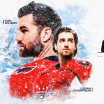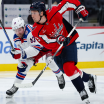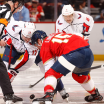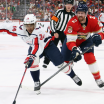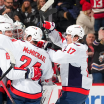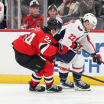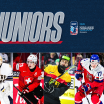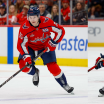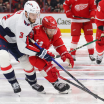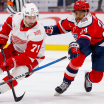This Wednesday night, the NHL's 32nd team will begin to take shape. The city of Seattle was officially granted an expansion franchise in December of 2019, and the club unveiled its logo and name - Seattle Kraken - last summer. On Wednesday, Kraken general manager Ron Francis will start filling those new sweaters with bodies ahead of the team's on-ice debut in October at the outset of the 2021-22 NHL season.
Creating the Kraken: Protected Lists Unveiled
Caps and 29 other NHL clubs submit protected lists as expansion Seattle Kraken gets set to shape its roster on Wednesday
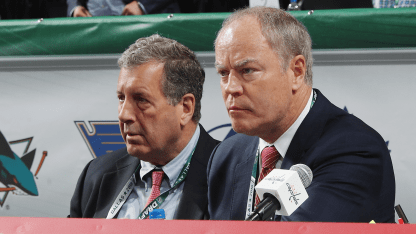
By
Mike Vogel
WashingtonCaps.com
Except for the Vegas Golden Knights, which joined the League as an expansion outfit and conducted its own expansion draft four summers ago, every team in the NHL will lose one player to the nascent Kraken this Wednesday. The 30 established teams are able to protect as many as 11 players - seven forwards, three defensemen and a goaltender - from the clutches of the Kraken, and they must expose at least two forwards, one defenseman and one goaltender to the Seattle club.
Teams with greater defensive depth can opt to protect four defensemen, but a team that chooses that route is then only able to protect four forwards for a total of nine skaters.
Before we delve further into the nuances of the draft and the protected lists, here is Washington's list of protected players, which was submitted on Saturday afternoon:
Forwards (7): Nicklas Backstrom, Lars Eller, Evgeny Kuznetsov, Anthony Mantha, T.J. Oshie, Daniel Sprong, Tom Wilson
Defensemen (3):John Carlson, Dmitry Orlov, Trevor van Riemsdyk
Goaltender (1): Ilya Samsonov
Because Caps captain Alex Ovechkin is an impending unrestricted free agent who has yet to sign a contract extension, Washington did not need to use a protection slot on him. The Kraken has an exclusive window in which it can negotiate with the League's impending UFAs, and if it were to come to terms with any of those players, it would fulfill the originating team's obligation of supplying a player to Seattle.
We're going to go ahead and predict that the Kraken won't be negotiating with or signing Ovechkin.
The Kraken will be able to choose from forwards Nic Dowd, Carl Hagelin, Garnet Hathaway or Conor Sheary, defensemen Brenden Dillon, Nick Jensen, Michal Kempny or Justin Schultz and goaltenders Pheonix Copley and Vitek Vanecek.
When all the dust settles on Wednesday night, Seattle must have 14 forwards, nine defensemen and three goaltenders - the other four players can be of any position of the Kraken's choosing - and it must draft at least 20 players who are under contract for the 2021-22 season. Additionally, the combined salaries of those 30 players must add up to 60 to 100 percent of the League's annual salary cap, which remains flat at $81.5 million for '21-22. The 60 percent floor of that figure is $48.9 million.
While Seattle builds from the ground up, 30 of the League's clubs are actively vying to minimize the damage to their own depth charts. As a result, we've seen a flurry of recent trade activity as teams move players around the league, trying to squeeze some value out of players they otherwise expected to lose to Seattle.
Four years ago, most of those type of deals were struck directly with Vegas, and we may yet see some of those trades involving Seattle in the week ahead. But several teams that actively attempted to mitigate their losses four years ago ended up with deep self-inflicted wounds as a result; Anaheim, Columbus and Florida come immediately to mind. This time around, teams found a way to help one another ahead of the expansion draft rather than aiding their newest nemesis any more than they would prefer.
The flat salary cap has also changed the landscape since the Vegas club came into existence in 2017. The stagnant cap has an inflationary effect many of the contracts signed immediately ahead of the pandemic; few - if any - of those deals would look the same if they were negotiated in the League's current economic climate, following two seasons shortened by the COVID pandemic and sharply decreased revenue streams throughout the league. The flat cap has led several teams - including Washington - to offload salary in order to facilitate contract extensions or other off-season shopping needs.
In the process of curating its own protected list over the last several weeks, Washington's aim is to keep as much of last season's team intact as possible, while creating enough salary cap space with which to sign both Ovechkin and Samsonov - who is a restricted free agent - to contract extensions. For those reasons, players such as Dillon and Schultz were not on the protected list. Dillon's salary cap figure is $3.9 million annually and Schultz's is 4 million.
With regard to its protected list, salary cap took precedence over hockey decisions. Because the Caps have seven players with annual salary cap hits of $5 million or more, they need to have a handful of players with much lower price tags deeper on their depth chart. While both van Riemsdyk and Sprong were in and out of the Washington lineup last season, both are under contract for less than $1 million this season, and both are also younger than most of the Caps' core. Both are likely to have larger roles this season, and Washington can roster the pair for less than $2 million in total.
The Caps have been preparing for this draft virtually since the last expansion draft. Washington has had to expose players that it would prefer to keep, and it will lose a player it would rather retain, as is the case with most of the League's better teams. But they've built up a fair amount of defensive depth since losing blueliner Nate Schmidt in the Vegas expansion draft, and they were able to offload Richard Panik's $2.75 million salary cap hit to Detroit at the trade deadline three months ago. Washington correctly assumed it would have company in trying to offload salary once summer rolled around, so getting Panik - one of those aforementioned inflationary contracts - off the books in April was a relief and a wise play in hindsight.
Francis and his hockey operations staff now have a few days to go over the protected lists and spend some time working with what amounts to an enormous jigsaw puzzle as they try to put together the best team possible. Part of that process involves talking with the other general managers and trying to squeeze them for picks and prospects if the Kraken will take this player instead of that one.
Once protected lists are made public on Sunday, the League's general managers can also peruse the list. Seeing an unprotected player who piques their interest, a general manager could call Francis and make a trade offer for the Kraken to take that player and subsequently flip him to the interested GM's team.
Seattle is seeking to build a representative team that can compete right out of the gate. That means four lines, three pairs and two goaltenders that make sense, and they may not be able to assemble such a crew based simply upon pulling the best player from every other team in the league. Francis might be able to bring in more value by playing a conduit role, and dispersing some of his draft choices around the league in pre-arranged deals.
Such an arrangement could be beneficial to other GMs around the league, too. In this flat cap environment, shopping for help via Francis and the expansion draft might prove to be more economical than shopping at the NHL's annual free agent emporium where competition can be heavy, the shelves are stocked thinly and randomly, and the prices are high. For this reason, it's also virtually impossible to predict which player the Caps are likely to lose when Wednesday rolls around.
We will know soon enough, but the entire process has a bit of a wild card feel to it and some surprises could be in the offing between now and Wednesday. The Caps' hands are virtually tied until then; they really can't move forward with their offseason roster planning until they know who Seattle is taking from them. Once the expansion draft is in the books, the Caps and the rest of the League will move swiftly into what is a condensed offseason. The regular schedule for 2021-22 will be unveiled on Thursday, the NHL Draft is this Friday and Saturday, and free agency gets underway on July 28. The weeks ahead will be busy around the Caps' offices and the rest of the League.


